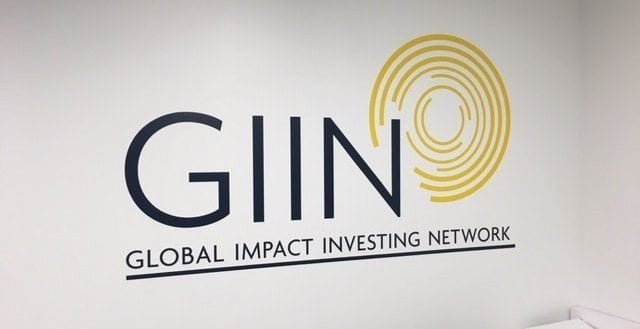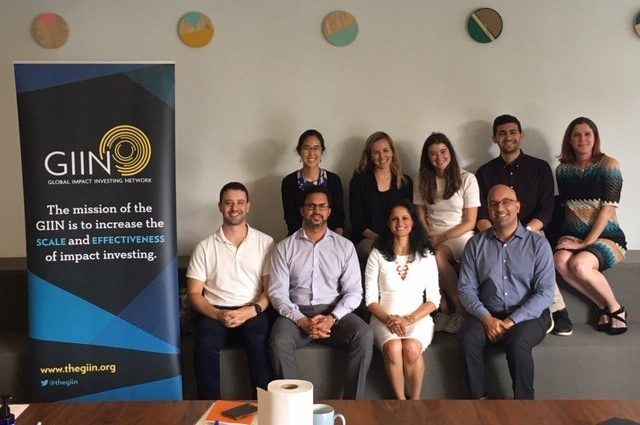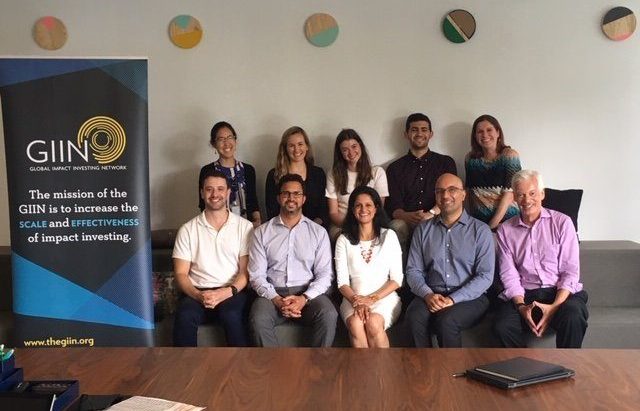Better Than Most is a regular feature of The Business of Giving, examining the best places to work among social good businesses and nonprofit organizations.
Denver: And this evening, you’ll be going to One Battery Park Plaza and to the headquarters of The GIIN, the Global Impact Investing Network. We’ll begin their chief executive officer, Amit Bouri, and then we will hear from other members of the team on why it’s such a special place to work.
Amit Bouri: So, when I think about the culture of the GIIN, it really goes back to our origin and what we were trying to do when we established the organization, and a big value to me is just the ethos of public service. We created the GIIN in service of the public and the greater good because we felt it was absolutely critical to build an organization that would help to transform the way that we think about investing, to move more capital from new sources to address social and environmental problems. At the same time, one of the things that we also knew is that we needed more leaders in the world who are thinking about a more integrated view about business, investment, the needs of society, and the planet together.
And so, one of the things that we try to do in the culture of the GIIN since our very earliest days is just do both of those things at the same time.

Arjun Reddy: The hiring process that’s unique to the GIIN…every candidate that’s put through the process, or almost every candidate, I believe, has to do something called an exercise. It was the first time I had done anything like that. It is literally a work project that you would expect to do in your role as part of the interview process and then present to the people that are interviewing you…but then I realized it’s actually useful and reflective of our kind of practical approach to hiring. We’re a small organization. We want to make sure that the people were looking at for a role can actually literally do what we ask them to do. And so, I thought that was pretty unique and I think it’s an interesting thing that we do. I think it’s reflective again of our culture and what we want out of our candidates and future employees.
Brianna Willams: One of the biggest things that our HR department launched a couple of months back were resources for our managers around creating goals for the first 90 days of new hires, how to break that out into 30-60-90 and kind of what those goals would look like.
They also created resources on how to hold a 90-day review conversation with your new hire. So just checking in on how they are acclimating to the culture and to their job and what are the challenges, what are their successes, and then creating goals moving forward.
Adam Dolin: I think somebody from outside would say that the GIIN is comprised of about 125 individuals. Would they be right? No. We are 35 or so right now. It’s pretty remarkable, if you go on our website and follow us through different channels, the amount of work that we’re putting out into the world and trying to actually create a real impact on all the topics that we try to touch. It’s pretty cool, and there’s a lot of ingredients that go into making that formula possible. You need a collaborative, intrinsic collaboration in the office. You need to be supported. You need to be supportive of others.

Jen Lawrence: But I think one of the things that kind of stands out to me as being different that I haven’t experienced in other places that I’ve worked is how thoughtful people are and how thoughtful they are despite having so much on their plates. As an example, I was working on a project— I’m just reviewing something for another team – and the next morning, I come to my desk and I have a handwritten note on my desk saying, “Thank you. I owe you a coffee” And to me, I’m like, “I’m just doing my job. Why do I need this?” But I think it’s very indicative of the people that work here who are just so nice and really just incredibly lovely to work with.
Katharine Zafiris: And then, when we’re like building out projects and hosting events, thinking about how we can collaborate with other teams and make sure that what we’re doing is known across the teams and so we have what we call need-to-knows that we do during our team meetings in which each team or the project team takes the time to share with the broader team of the work that they’re doing to make sure that it’s known across the team.
Naoko Kimura: I think particularly the Tuesday team–the organization-wide meetings, for example, when Amit reflects on his recent touchpoints and things like that, but then also kind of on the broader industry, what we’re seeing politically in the economy, making these recent events more relevant to the work that we do and putting that into perspective in terms of what we’re trying to achieve as an organization and kind of the longer vision, the mission. It’s very easy to get caught up in the day-to-day…but having this reminder of what it is that we’re trying to achieve as an organization really helps to reinforce why we’re here, and at least for me personally, is very motivating and drives me to want to do more individually but then also as a team, and I hope that would apply across other colleagues as well.
Sapna Shah: I think we’re a really unique and special group of people that I think sort of, in some ways, set tones that are positive for the overall organization in that the group that we have—obviously, everybody represents a specific department—but when we get together, it’s clear that everyone in the room is thinking about what’s the best in the interests of the organization, stepping out of their own specific shoes often. It’s an environment of mutual support and respect, and celebrating shared wins and collaboration, and increasing candor as well, which I think speaks to the respect part. So, I’ve really appreciated that because I think that sets a really positive tone for just how we celebrate the organization’s wins regardless of what team we sit on.
Ben Ringel: So, our building management organizes a concert series over the summer, and on the front steps of the building, they bring in musicians every Tuesday – everything from Motown to country to classic rock. And because we are lucky enough to be on the second floor, it is directly outside of our window. So when it’s a good band, obviously, it’s a group sing-along session and we’re all singing either Free Falling or something. And if the band isn’t as talented, then it’s bonding by commiseration. But regardless, I think that it’s a very easy talking point if you’re new. I only started at the GIIN two months ago and having that to joke about and bond about with all of my colleagues, it was really nice to talk about something that wasn’t work-related all of the time and it really did make me feel like I was a part of the team, even if it was more tangential. But I found it to be a really good experience.
Arjun Reddy: I’d like to talk about the vibe of the office and how the office space reinforces our culture. There’s a lot of natural light. There’s plenty of windows. We were intentional about creating multiple walking pathways for you to interact with your colleagues and definitely lots of meeting space in order to collaborate, to kind of reinforce our collaborative nature.
In terms of what it reinforces about our culture, I think that when you walk into the office, you see that it’s modern, professional, kind of minimalist, and I think that from that we can see a new way, we want to reflect a new way of thinking not just about work, but also financial markets and investing, which is what our organization is all about.

Adam Dolin: There are the implicit perks that I think are unique to the GIIN and make it very special here. One is that as I answer this question, I am looking at a tree line. And when we think about our work at the Global Impact Investing Network, we often characterize our impact as affecting either people or planet. Now, in New York City, there’s no shortage of people, but you can lose a sense of your connection to the planet in the city. And so, working right on the tip of Manhattan near Battery Park, having a view of trees from the second-floor window, is something that I do not take for granted. I really appreciate that.
Sapna Shah: The second thing I would comment on is I think a great perk, and especially something that I value in the context of us being a small organization and a nonprofit, which is that we have a dedicated space right next to us where we are for nursing mothers that I made quite a bit of use out of that space last year. I think coming back to work leaving a three-month-old at home and wanting to commit to nursing her is a pretty daunting and challenging experience, but we have a room that is so comfortably and thoughtfully set up for that purpose. It’s made clear to staff that that the room is to be prioritized for nursing mothers, and I’m grateful to work in a place that where the staff also was always very respectful of my need to kind of take breaks throughout the day. I’ve worked here for a long time. I’ve gotten to work on a lot of cool projects at the GIIN. I’m pretty confident that at some point tonight, when I no longer work here, that some of my specific memories about specific things I’ve done might start to fade, but the kind of gratitude I have for being able to come back to work and feed my daughter will never fade.
Brianna Willams: I think GIIN is bringing in some of these new leadership ideas and is being very future-oriented in their organization by having a focus on their people as well. We really put pride in professional development here and really wanting to build those leaders that Amit was just talking about and really wanting to see our staff succeed to their fullest. We have a mentorship program within the GIIN, which is kind of unheard of in a nonprofit, and really wanting to give that space for our staff to grow from somebody at a different point in their career as well as have a safe sounding board as you are maneuvering yourself through your own career and the own paths in the GIIN as well.
Katharine Zafiris: And then before there’s an actual conversation between managers and their supervisees, we do a 360 review. This is something for sure, when I’ve talked with family and friends about, that I think is really unique, in that we get to get feedback from other people we work with and we each have the chance to hear from three to four other members of the team, both whether on our direct team or those we’ve worked on a specific project with and get their feedback as well. And then, all of that is brought to the manager and then there’s that conversation that both involve that 360 feedback as well as their direct feedback in working with that person.
Jen Lawrence: So, every year we do a staff retreat for a couple of days, and this past year, we did this thing called “Accountabili-buddies,” which is kind of an embarrassing term, but it’s really fun to say. So in that kind of small group, we broke up into groups of two or three with people that we don’t generally work very closely with across the organization, and we were given all sorts of prompts throughout the couple of days that we had our staff retreat and kind of really had quite like intimate personal conversations about what we were hoping to get out of our year, what we were hoping to get out of our career, where we see ourselves in five years, 10 years. We did a visualization of “Ten years from now, you’re waking up. What does it look like on your commute to work?” It really kind of forced us to have conversations that were definitely outside of our normal day-to-day and connect personally with people in the organization that we don’t generally get to connect with.
Naoko Kimura: But I think in terms of diversity and in our attempts to be inclusive, both on the professional side but also personally, because we’re such a group of thoughtful individuals, I think that allows us to be kind of ourselves, which enables this inclusive environment which then leads to more diversity in thought, whether it’s towards how you approach your work or a specific issue that you might be encountering, either within the work workplace or thematically as well. But then also as an individual, your interest outside of the office, your beliefs, your values, there’s really I think an inclusive culture that’s not necessarily forced but just what everyone as individuals brings to the office.
Amit Bouri: And it’s really quite special to be a part of that for so many amazing people that this time that they spent at this organization ends up being quite pivotal for their lives and that goes for me as well. Some of the greatest kind of developments in my life have happened while I was employed here. I’ve also had a number of big challenges and experienced kind of the celebration with my colleagues at the GIIN and also support when I really needed it. I think that’s something that’s very powerful to me for the culture. I’m grateful to be on the receiving end of it. I’m also grateful to be part of an organization that is providing that to others when they need it.

Denver: I would like to thank Amy Stillman for organizing my visit and for all those who contributed to this piece: Ben Ringel, Brianna Williams, Arjun Reddy, Jen Lawrence, Katherine Zafiris, Naoko Komura, Adam Dolin and Sapna Shah. To hear this again, read the transcript or see pictures of the participants and the offices of The GIIN, simply come visit denver-frederick.com where we’ll post a link to my full interview with Amit Bouri, the CEO of the Global Impact Investing Network.
The Business of Giving can be heard every Sunday evening between 6:00 p.m. and 7:00 p.m. Eastern on AM 970 The Answer in New York and on iHeartRadio. You can follow us @bizofgive on Twitter, @bizofgive on Instagram and at http://www.facebook.com/BusinessOfGiving

